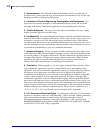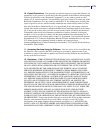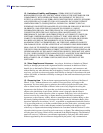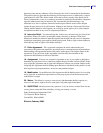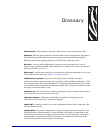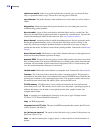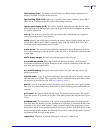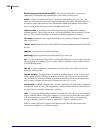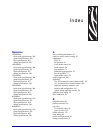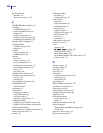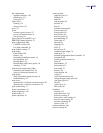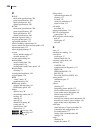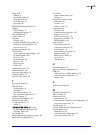
Glossary
220
13383L-004 Rev. A XiIIIPlus/R110Xi/R170Xi User Guide 9/6/07
Radio Frequency Identification (RFID) The technology that allows an item to be
identified by a transponder that communicates with a reader via radio waves.
ribbon A band of material consisting of a base film coated with wax or resin “ink.” The
inked side of the material is pressed by the printhead against the media. The ribbon transfers
ink onto the media when heated by the small elements within the printhead. Zebra ribbons
have a coating on the back that protects the printhead from wear.
ribbon wrinkle A wrinkling of the ribbon caused by improper alignment or improper
printhead pressure. This wrinkle can cause voids in the print and/or the used ribbon to rewind
unevenly. This condition should be corrected by performing adjustment procedures.
roll media Media that comes supplied rolled onto a core (usually cardboard). Contrast this
with fanfold media.
“smart” label Media that comes with an RFID transponder embedded between the label and
the liner.
supplies A general term for media and ribbon.
symbology The term generally used when referring to a bar code.
tag 1) A type of media having no adhesive backing but featuring a hole or notch by which the
tag can be hung on something. Tags are usually made of cardboard or other durable material.
2) An RFID transponder.
tear-off A mode of operation in which the user tears the label or tag stock away from the
remaining media by hand.
thermal transfer A printing method in which the printhead presses an ink or resin coated
ribbon against the media. Heating the printhead elements causes the ink or resin to transfer
onto the media. By selectively heating the printhead elements as the media and ribbon move
past, an image is printed onto the media. Contrast this with direct thermal.
transponder An RFID component that is usually comprised of an antenna that is bonded to
an integrated circuit (IC) chip. The transponder is usually located between the label and liner
in “smart” labels (sometimes called a tag or an inlay).
void 1) A space on which printing should have occurred, but did not due to an error condition
such as wrinkled ribbon or faulty print elements. A void can cause a printed bar code symbol
to be read incorrectly or not at all. 2) An RFID label is “voided” if an error occurs during
writing or encoding. The label is ejected, and the word “VOID” is printed across it.
WEP is a security protocol for wireless local area networks (WLANs) that secures data
transmissions using 64-bit or 128-bit encryption.



